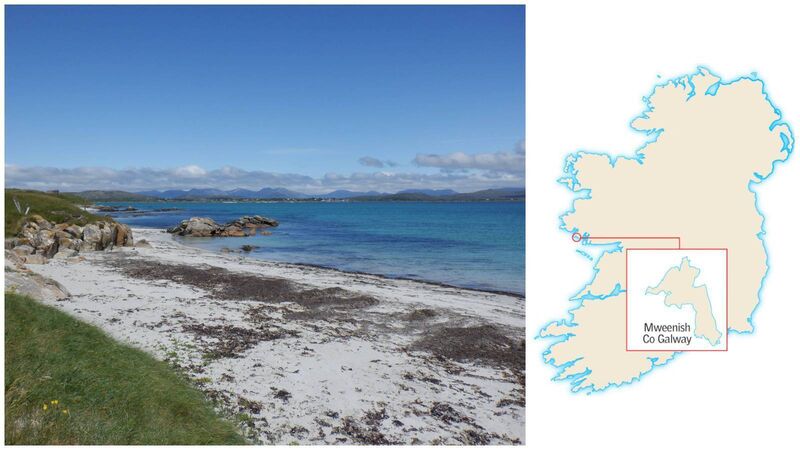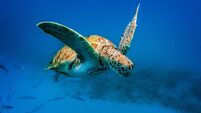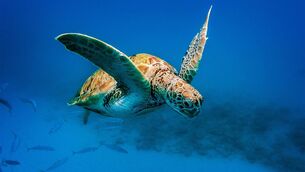Islands of Ireland: Granite shores, sandy beaches and blue skies at Mweenish

Mweenish Island lies due south of the County Galway village of Carna and between Bertraghboy Bay and Kilkieran Bay.
Nature created some sort of magnificent balancing act at Mweenish Island in Connemara. The wild, wild western coastline battered by huge, merciless waves that have crossed the Atlantic is counterpointed here by a benign eastern aspect whose sandy beaches rival the Caribbean’s.
Among its granite shores and tidal pools images of the reflected bright blue sky can dazzle with their beauty. In the distance loom the Twelve Bens and Lough Oran lies near the centre of the island like a watchful eye. Maínis, or island of the plain, is well named as its highest point is just 23 metres.
Felt Mediterranean on Mweenish Island last week #Connemara #Galway pic.twitter.com/w2GBaoC2ua
— Dr Richard Scriven (@RichardScrivGeo) August 30, 2021
The island lies due south of the County Galway village of Carna and between Bertraghboy Bay and Kilkieran Bay. It is in a well-established Gaeltacht area with summer schools well attended each year.
It is surrounded by other islands of varying sizes: Feenish; Inishmuskerry; Duck; Mason and St MacDara’s Island on the east, west and south. All were once populated, and all are now abandoned.
To the north there are the very small Joyce’s Island, Carra Island and Rushhenacholla, through which the causeway and bridge were built by the Congested Districts Board in 1886 to connect the island to the mainland.
It may then have technically lost its island status according to geographers but prior to the causeway it was most definitely an island and this period defined its character today. Islandness is as much a state of mind as it is of geography.
Mweenish Island will forever be associated with the Galway hooker and the boatbuilding skills of the Mulkerrins and the Casey family. In 1897, Martin and John Casey built a boat that they christened the St Patrick.
Maínis💙 #oilpainting #Mweenish #Conamara #Galway #connemara pic.twitter.com/Z0TNFdoTM0
— Aoife Dowd Artist (@Aoifedowdartist) August 25, 2022
Fast forward more than half a century and the same boat was sailed across the Atlantic to New York in 1986 by Paddy Barry and crew to celebrate the centenary of the Statue of Liberty. Unfortunately, nothing is indestructible and the St Patrick sank in a storm in Glandore, West Cork in 2002.
Other noble practitioners of the boatbuilding art on Mweenish came from the Clohertys, Folans, Gearys, Greenes, Mulkerrins and others.
The island was affected severely by emigration over the years, a sentiment which is expressed in the sean nós air ‘Amhrán Mhuínse’ or ‘The Song of Muighinis’
The entire coastline in this area stretching from Spiddal near Galway City up to Renvyle has dozens of holy wells. One of them on Mweenish is known as the Well of the Seven Daughters which was dedicated to the daughters either of a King of Leinster or a chieftain of Omey Island.
Mweenish had a population of 649 people in 1841 who would have subsisted on fishing and some farming. However, in the following decades the population plummeted, not helped by the notorious landlord and MP Colonel Nolan whose “harsh and unparalleled oppression of his Mweenish tenantry” contributed to the demise, not least over the meagre harvesting rights of kelp. Nolan was ousted from the United Irish League as a result of his treatment of his tenants.
Turtle on Mweenish beach this morning 🐢
— Days of the MV Naomh Éanna, Ireland (@MVNaomhEanna) December 16, 2021
Is that a first? We believe that animal welfare have been informed of it and have taken it to Galway.
Many thanks to Mary Hopkins for sharing the photo with us. pic.twitter.com/q0mjYhpN6a
Mweenish life was extolled in the memoirs of one of its sons Séamas Mac Con Iomaire entitled . It is quoted here from Tim Robinson’s no mean interpreter of Connemara himself.
“In the summer when the sea round is calm and smooth, my island is a lovely place. The fine white sand dazzling under the rays of the sun. Patches of rye and potatoes mantled with thick foliage. To the east of our cottage a fine stretch of level green reaches down to the sea. On this grassy bawn one notices hundreds of tiny buttercups, primroses, daisies and bluebells, each not much bigger than a pin’s point.”
As well as these colourful flowers the poisonous hemlock is said to grow on the island. Yin and yang.
: Take the N59 from Galway and turn south for a 36km drive on the R336a at Maam Cross.
: galwayhookersailingclub.ie; Freeman’s Journal, January 9, 1902








